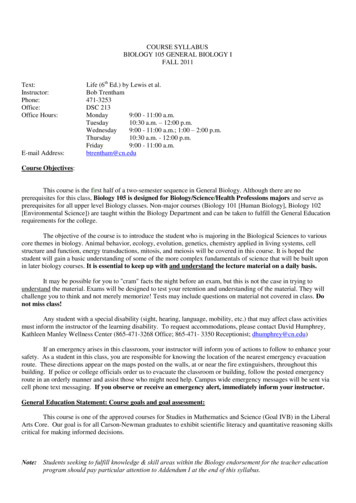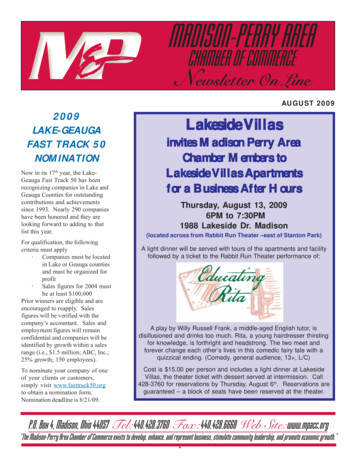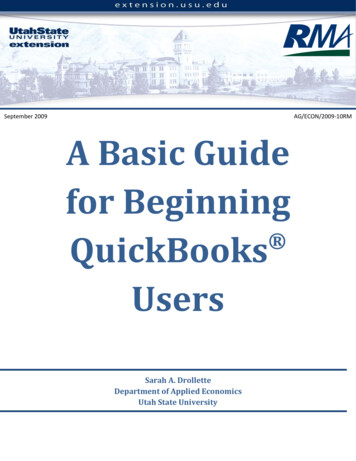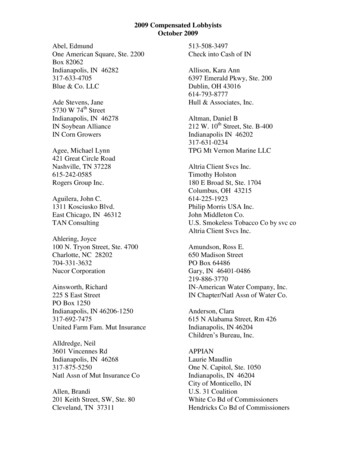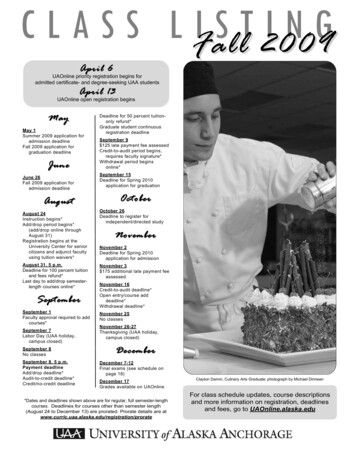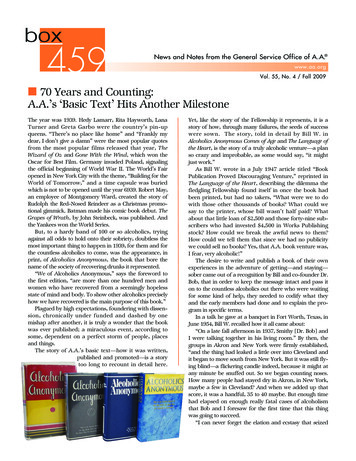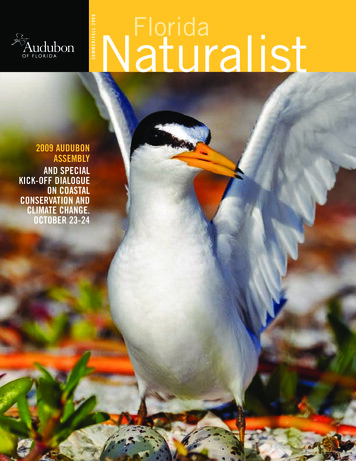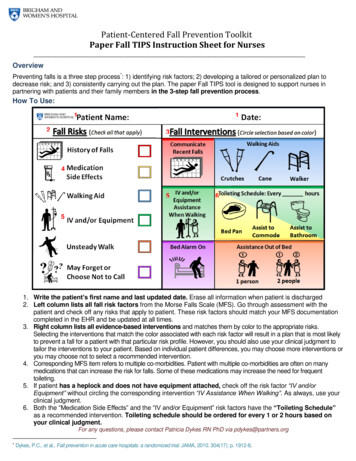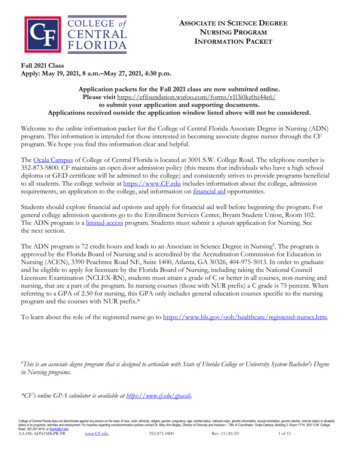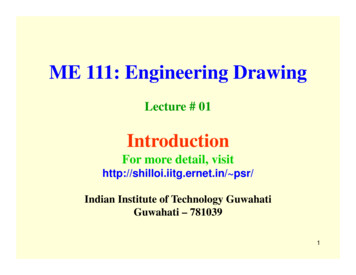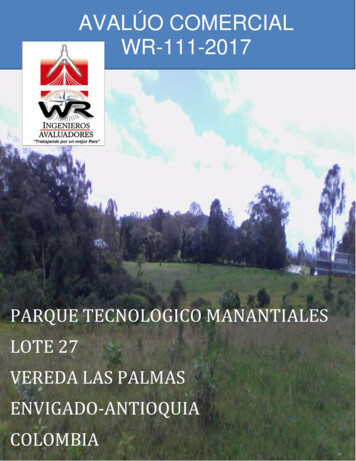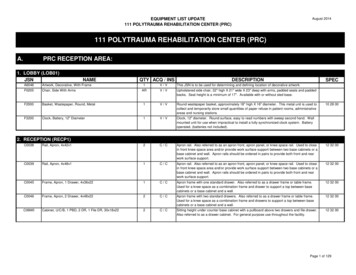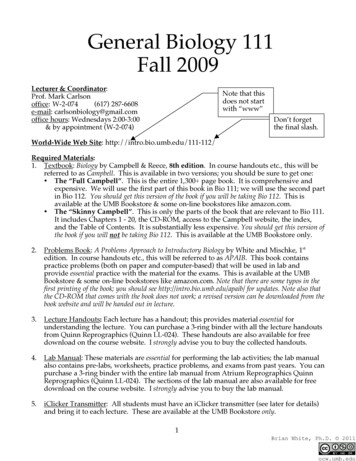
Transcription
General Biology 111Fall 2009Lecturer & Coordinator:Prof. Mark Carlsonoffice: W-2-074(617) 287-6608e-mail: carlsonbiology@gmail.comoffice hours: Wednesdays 2:00-3:00& by appointment (W-2-074)Note that thisdoes not startwith “www”Don’t forgetthe final slash.World-Wide Web Site: http://intro.bio.umb.edu/111-112/Required Materials:1. Textbook: Biology by Campbell & Reece, 8th edition. In course handouts etc., this will bereferred to as Campbell. This is available in two versions; you should be sure to get one: The “Full Campbell”. This is the entire 1,300 page book. It is comprehensive andexpensive. We will use the first part of this book in Bio 111; we will use the second partin Bio 112. You should get this version of the book if you will be taking Bio 112. This isavailable at the UMB Bookstore & some on-line bookstores like amazon.com. The “Skinny Campbell”. This is only the parts of the book that are relevant to Bio 111.It includes Chapters 1 - 20, the CD-ROM, access to the Campbell website, the index,and the Table of Contents. It is substantially less expensive. You should get this version ofthe book if you will not be taking Bio 112. This is available at the UMB Bookstore only.2.Problems Book: A Problems Approach to Introductory Biology by White and Mischke, 1stedition. In course handouts etc., this will be referred to as APAIB. This book containspractice problems (both on paper and computer-based) that will be used in lab andprovide essential practice with the material for the exams. This is available at the UMBBookstore & some on-line bookstores like amazon.com. Note that there are some typos in thefirst printing of the book; you should see http://intro.bio.umb.edu/apaib/ for updates. Note also thatthe CD-ROM that comes with the book does not work; a revised version can be downloaded from thebook website and will be handed out in lecture.3.Lecture Handouts: Each lecture has a handout; this provides material essential forunderstanding the lecture. You can purchase a 3-ring binder with all the lecture handoutsfrom Quinn Reprographics (Quinn LL-024). These handouts are also available for freedownload on the course website. I strongly advise you to buy the collected handouts.4.Lab Manual: These materials are essential for performing the lab activities; the lab manualalso contains pre-labs, worksheets, practice problems, and exams from past years. You canpurchase a 3-ring binder with the entire lab manual from Atrium Reprographics QuinnReprographics (Quinn LL-024). The sections of the lab manual are also available for freedownload on the course website. I strongly advise you to buy the lab manual.5.iClicker Transmitter: All students must have an iClicker transmitter (see later for details)and bring it to each lecture. These are available at the UMB Bookstore only.1
Course Policies:Lectures: Lectures meet in Lipke Auditorium: Mon, Weds, Fri 12:00 to 12:50; regularattendance is expected. Extra copies of handouts can be found outside W-2-074.Lab Sections: Lab sections meet in W-2-030 and -032. Some labs involve hands-on activities;others involve problem-solving exercises. Lab sections will be assigned during the first weekof class; you may not switch sections after that time. Attendance in lab is expected.In an emergency, you may make up a missed lab by attending another section thatmeets during the same week with the permission of the TA; TAs may refuse entry to studentsonce the section is full. You may attend only one make up lab section per semester; after that,if you attend a lab other than the one to which you have been assigned, you will be allowed toattend that lab but your pre-lab and any other materials due in that lab will not be graded.You must read the lab manual before lab. Some labs have pre-lab exercises based on thelab manual; these are due at the start of lab and will not be accepted late. You will not beadmitted to lab unless you have a copy the lab manual, the APAIB book, and a completedpre-lab with you.The lab sections are as follows:Section TimeRoom1Tu 9:30 - 12:30 W-2-0302Tu 9:30 - 12:30 W-2-0323Tu 2:00 - 5:00W-2-0304Tu 2:00 - 5:00W-2-0325We 8:30 - 11:30 W-2-0306We 8:30 - 11:30 W-2-0327We 1:00 - 4:00 W-2-0308We 1:00 - 4:00 W-2-032Section910111213141516TimeTh 9:30 - 12:30Th 9:30 - 12:30Th 2:00-5:00Th 2:00-5:00Fri 8:30 - 11:30Fri 8:30 - 11:30We 5:30 - 8:30 PMWe 5:30 - 8:30 2-030W-2-032Note: lab sections are very full - if you do not fill out a student information sheet at the firstlecture, your space in lab will be given to another student even if you are registered for theclass.Readings: Lectures and readings are designed to be complementary. Often, the emphasis oflecture will be different from the book. Although the course emphasizes lecture material morethan readings, exams will draw freely from both lectures and readings.Discussion Section: Tuesdays 12:30 - 1:20 in W-2-032. I will lead a group discussion of theweek’s material as a tutorial for you and an opportunity for me to understand how you arelearning the material. Attendance is encouraged but not required.Exams: There will be four exams: three 50-minute exams given in class during the semesterand a comprehensive 3-hour final exam. There will be no make up exams. No conflict examswill be given. If you arrive more than 5 minutes late to an exam, but before the first person hasfinished the exam, you will be given as many minutes as you were late as extra time after theexam. We may offer exams held in the laboratory at the same time as the lecture exams ifthere is space available. We will drop the lowest grade of the three 50-minute exams whencalculating your overall grade. The final exam will be scheduled during the semester. The finalexam score cannot be dropped. You may bring a single 8.5 x 11 sheet of paper with whateveryou want on it to each exam.2
Exam123FinalLectures CoveredIntroduction 1 through Genetics 7Chemistry 1 through Biochemistry 9Molecular Biology 1 through Cell Biology 1Introduction 1 through Cancer 5 with emphasis on Cancer 1through Cancer 5Exam Re-grades: Occasionally, we make mistakes when grading. If you feel that your examwas graded in error, you can request a re-grade. Instructions and notes for re-grading: Re-grades must be in writing; because different TAs graded different questions, neitherI nor your TA can re-grade your exam “on the spot”. When asking for a re-grade, you should include the following:o Your whole exam. Do not mark on it in any way. In order to prevent cheating,we xerox or scan some or all of the exams; any marks made on your exam after itwas graded and given to you in lab may be interpreted as cheating. Studentswho alter their answers and submit these altered answers for a re-grade willreceive a grade of “F” for the course and a letter will be sent to the Dean ofUndergraduate Education notifying him/her of the incident.o A note on a separate piece of paper (attached to your exam) explaining whatneeds to be re-graded. Don’t simply say, “Re-grade question 3”; you shouldexplain why your answer deserves more credit that we gave. If it is an additionerror, explain which numbers were added up incorrectly.o Re-grade requests that do not follow these rules will be returned without review. Re-grade requests must be turned in to your TA or Mark Carlson within 2 weeks of thedate the exam was handed back in lab. Re-graded exams will be returned in lab about 2 weeks later.Snow days: If class is cancelled due to snow, check the web site or my office phone forannouncements. In general, snow days before exams will not cause the exams to be moved; if asnow day falls on an exam day, the exam will be held in the next lecture period.Tutor-led Study Groups: There are several tutors to help students in Bio 111. Tutoring is freeand open to all students. The tutors will lead weekly study group workshop sessions wherethey will go over that week’s APAIB problems as well as answer questions. Regularattendance is strongly encouraged.Software from A Problems Approach to Introductory Biology will run on almost any computer,Mac or PC. It is also set up to run on some of the computers in the Library. In the Red lab(Healey Library UL), it is set up on the PCs only. You can access the programs from theprograms menu; look in the “B. White APAIB” sub-menu; you can also run it from the CD onthese computers. The software is also available on the PCs on the 4th floor of the Library andon the 2nd floor on the computers behind the Cafe.You will need to get a new copy of the CD to run the software on a PC. You candownload the CD from the book website (http://intro.bio.umb.edu/apaib/); I will also behanding out free copies in lecture.3
Lecture & Lab troduction 1: OverviewIntroduction 2: Science as a ProcessGenetics 1: MendelGenetics 2: Solving Genetics ProblemsGenetics 3: Cells, Mitosis, & MeiosisGenetics 4: Sex LinkageGenetics 5: PedigreesGenetics 6: Solving Pedigrees & RiskGenetics 7: Applications & LimitationsChemistry 1: AtomsChemistry 2: Covalent BondsChemistry 3: Non-Covalent Bonds IChemistry 4: Non-Covalent Bonds IIChemistry 5: Water ChemistryColumbus’ DayBiochemistry 1: Macromolecules 1Biochemistry 2: Macromolecules 2Exam IBiochemistry 3: Protein Structure IBiochemistry 4: Protein Structure IIBiochemistry 5: Energy & BondsBiochemistry 6: CatalysisBiochemistry 7: Enzymes & MetabolismBiochemistry 8: ATP & GlycolysisBiochemistry 9: Respiration, etc.Molecular Biology 1: DNA ReplicationMolecular Biology 2: TranscriptionVeterans’ DayMolecular Biology 3: TranslationExam IIMolecular Biology 4: Introns & GenomesMolecular Biology 5: Genes & Mutation IMolecular Biology 6: Mutation II & VirusMolecular Biology 7: HIV/AIDSThanksgivingCell Biology 1: Cells & OrganellesCancer 1: IntroductionCancer 2: Growth Factors & Cell SignalsExam IIICancer 3: Oncogenes & MutationsCancer 4: Genetics & TreatmentCancer 5: The Big Picture4Lab & [Due Date]NONE01: Virtual Genetics Lab I[VGL I report due week of 9/21]02: LEGO MitosisGenetics Practice Problems I[Mitosis rept. due week of 9/28]03: LEGO MeiosisGenetics Practice Problems II[Meiosis rept. due week of 10/5]04: Virtual Genetics Lab IIAipotu I[VGL II report due week of 10/12]05: Chemical Structures06: Chemical Properties07: Green Fluorescent Protein[GFP report due week of 11/2]08: Protein Structure[Protein Structure report dueweek of 11/16]NONE09: Aipotu II[Aipotu II report dueweek of 11/30]NONE10: LEGO DNA[LEGO DNA report due week of12/7]11: Aipotu III[Aipotu lab due in lab this week]NONE
Reading ListLectureReadings in CampbellActivities onCampbell websiteAPAIB Problems{except these}Introduction 1Introduction 2Genetics 1Genetics 2Genetics 3Genetics 4Genetics 5Genetics 6Genetics 7Chemistry 1Chemistry 2Chemistry 3Chemistry 4Chemistry 5Biochemistry 1Biochemistry 2Biochemistry 3Biochemistry 4Biochemistry 5Biochemistry 6Biochemistry 7Biochemistry 8Biochemistry 9Cell Biology 1Molecular Biology 1Molecular Biology 2Molecular Biology 3Molecular Biology 4Molecular Biology 5Molecular Biology 6Molecular Biology 7Cancer 1Cancer 2Cancer 3skim 1-1718-24; 262-264264-267; 269-273228-234; skim 248-257286-288; 289-292; 297-300276-281269-270279-281; 300-30230-3738-42; 58-6640-43; 46-4739-4150-5168-7777-8181-8384142-148; 151-152153-154; 326-327151-155149-151; skim 162-169Skim 170-179; skim 185-18994-101; 125-12986-89; 305-310311-318325-334337-344334-335; 356-358; 426-434344-346381-390242-243; 373-376206-211376-37714.1 Monohybrid only14.2; 14.312.2; 12.315.1, 15.214.42.22.3 Covalent only4.2 Isomers only5.15.48.18.48.39.1; 9.2; 10.16.2; 7.1; 7.25.5; 16.116.217.1 activity; 17.217.417.312.3, 19.2, 19.311.3-Ch1: 1; 1.1.all* {1.1.2}; V1;V2; 1.3.all {1.3.4-1.3.7}; V3Ch1: 1.4.all; V4Ch1:1.2.all{1.2.5};1.5.all{1.5.1}Ch1: 3.8; 3.9Ch2: 1.1.all; C1Ch2: 1.2.allCh2: 2.1.allCh2: C3Ch2: 2.3.all; C5Ch2: 2.4.all; 2.5.all; C6Ch2: 3.1.1; 3.1.3Ch2: 3.1.4; 3.1.7; C7; C8Ch2: 3.1.2; 3.3.1-3.3.4Ch2: 3.3.5-3.3.7Ch3: 1.all; 2.all; C1Ch3: 3.diagnostic onlyCh3: 4.1.allCh3: 4.2.allCh3: 4.1.all;{4.1.2};4.2.all, C2Ch4: all-* Note that “1.1.all” means “all problems that start with number 1.1”; in this case, it is 1.1.1through 1.1.7. Problems in {braces} will be worked in lab.Readings and ActivitiesThe readings in Campbell are intended to be read before the lecture listed. Because thereadings do not always go in the order found in the book, it may be useful to review byreading all the sections in page order rather than the order on the reading list. The activitieson the Mastering Biology website are intended to help reinforce the concepts learned in lecture.The practice problems in APAIB are designed to be worked after the lecture listed. Youwill notice that some lectures have many problems while others have none. In general, by theend of the lecture listed, you have all the information necessary to solve the problems listed.Some of these problems will be worked each week in lab to show you problem-solvingstrategies. You do not have to do all the listed problems after each lecture; you should be sureto have done them all before the exam on that material.5
Note: the solutions to the practice problems in APAIB are an essential part of the book. Youshould read them over carefully after you have written out answers to the problems in thebook.Grades: Your final grade will be calculated as follows:40% hour exams (20% for each of your best 2 grades)20% final exam40% Lab: Your lab grade will consist of 580 points, divided as follows:Done at home & handed in at start of labWork done entirely in labPre-labs11 x 10 pts 110VGL I CheckoffVGL I Report30Mitosis CheckoffMitosis Report15Meiosis CheckoffMeiosis Report25VG
the book if you will not be taking Bio 112. This is available at the UMB Bookstore only. 2. Problems Book: A Problems Approach to Introductory Biology by White and Mischke, 1st edition. In course handouts etc., this will be referred to as APAIB. This book contains practice problems (both on paper and computer-based) that will be used in lab and
